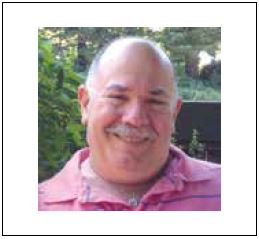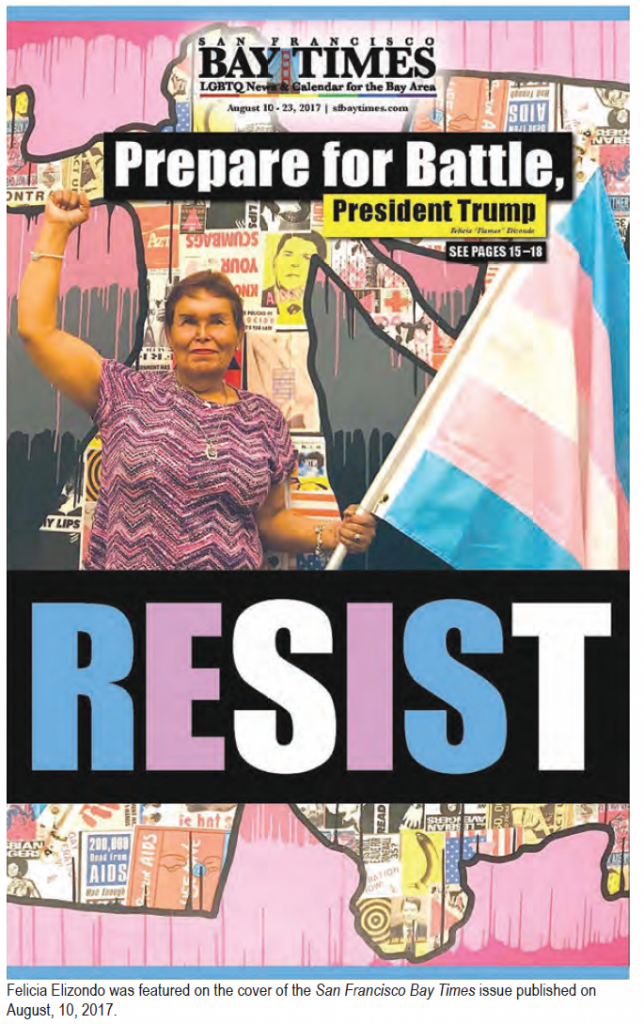
By Dr. Bill Lipsky–
For many, putting together the pieces of the puzzle that is us can be relatively easy. Self-awareness, support from family and friends, easily available information, and experimentation help us to become who we are. Not so for Felicia Elizondo. Despite all the prejudice, inaccuracy, and obstacles put in her way, however, she came not only to realize her true self, but also to find the strength and the courage to live an authentic life.
Growing up, Elizondo struggled to understand who she was. Born in San Angelo, Texas, on July 23, 1946, she was identified on her birth certificate as male and baptized as Felipe. At an early age, she knew she was different from the children around her, but she did not yet understand what exactly that meant for her. They called her a “sissy” and she believed them. She later said, “There’s no other way that I could feel just what I was feeling.”
Being a “sissy” then had only one explanation: “I thought I was gay, but I wasn’t.” Information about sexuality, especially for young people, was difficult to find and often untenable in the homophobic 1950s, so she learned that “being gay was against the law, and it was sick, and mental.” She never considered that she might be transgender “because I didn’t know the meaning of transgender or transsexual at the time.” Hardly anyone did.

When she was 14, her family moved to San Jose, California. Being seen as different, she was teased mercilessly by students at her high school. “They used to say horrible things to me—it was just embarrassing—and I hated to go to school,” she told the San Jose Trans Oral History Project in 2019. Around the same time, however, she discovered that St. James Park, site of a notorious lynching in 1933, was a popular gay cruising spot.
“I started going there,” she said. “I met a whole bunch of kids … . There was my best friend Bernie, Tommy, there was a whole list of them.” There also was another attraction. “We used to, uh, prostitute. You know, the older men used to come and give us money for whatever they wanted us to do. That’s how we got to be in a group.” The men considered Elizondo to be “a really good-looking boy at one time and I used to get a lot of money.”
Around the age of 15 or 16, she began seeing an older man who one day took her to San Francisco, where they visited the Tenderloin. “I noticed that there was a lot of people like me,” she later told Zachary Drucker of Vice News. “My God, it was the Mecca of gayness.” Soon, she and Bernie would “play hooky from school and come into the Tenderloin on a Greyhound from San Jose,” where Compton’s Cafeteria became “the center of the universe for us.”
By the time she graduated high school, Elizondo had decided she did not want to be gay any longer. She and her friends “were lost souls trying to understand what future was in store for us.” What she wanted instead was “to be normal,” she told Anita Whites of the Veterans History Project in 2007, not yet understanding what normal was for her. “I didn’t even know that I was transgender at the time because I didn’t know the meaning of transgender or transsexual at the time.”
She tried to enlist in the Army, but the Army declined to accept her because, standing 5’2”, she did not meet their height requirements. She joined the Navy instead. “If the Navy didn’t make me a man, nothing would,” she decided. After completing basic training, Elizondo was stationed at the naval base in Coronado, California. “Then I decided that I wanted to volunteer for Vietnam because maybe I would get killed and maybe all this hurt and pain would go away.”
She was in Vietnam about six months before the pressure of “passing for straight” became too much for her. “Being in Vietnam, being in Da Nang and stuff like that, and seeing all those men! My god!” A charge that she was AWOL (with a French teacher) led her finally to tell the Navy she was gay. She returned to the Bay Area with a dishonorable discharge, although later she successfully petitioned to have it changed to honorable.
The pieces of the puzzle of who she was came together while she was living in Chicago. “What changed my life was when I went to see the movie The Christine Jorgensen Story,” the so-called biography of the most famous transgender woman of her time, made by the gay director Irving Rapper, who also directed Bette Davis in five films. “I finally realized that this is who I am. I didn’t know how I was going to get there, but where there is a will, there is a way.”

Elizondo found a way. Moving back to San Jose, she eventually got a job with Pacific Bell as the first male long-distance operator in California history. In 1972, she began living full-time as a woman. Two years later, when she completed her surgery, she finally was her true self. She was still working for the telephone company in 1987 when she was diagnosed with HIV.
After retiring, she moved to San Francisco “because the best possibility of surviving AIDS was the mecca of the medical center of everything.” She became deeply involved with organizations helping people living with HIV and AIDS, including the Shanti Project, Project Open Hand, and PAWS. She estimated that she also made some 80 panels for the AIDS Memorial Quilt.
Elizondo additionally became an advocate for the transgender community, especially other transgender women of color, who often were confronted with both racism and transphobia. She worked to keep alive the history of the Tenderloin as a haven, however tenuous it was, for trans people 50 years before. “Please don’t forget all who came before you,” she wrote in 2018, three years before she died. “You have to know where you have been to know where you are going.”
Bill Lipsky, Ph.D., author of “Gay and Lesbian San Francisco” (2006), is a member of the Rainbow Honor Walk board of directors.
Face from Our LGBT Past
Published on September 8, 2022
Recent Comments